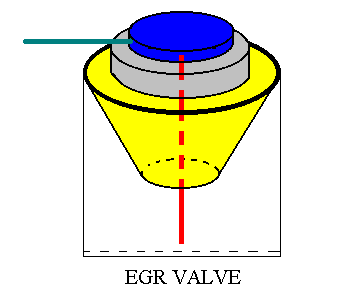PROPER CARE
Inspecting Your EGR Valve
*MEDIUM*
You should occasionally inspect the operation of your EGR valve where possible and the condition of its hoses. EGR valve design varies; the ones that have an exposed valve stem can be visually inspected. If your engine is equipped with such an EGR valve, inspect it as follows:
- Park the vehicle on level ground in a well-ventilated area with the engine OFF, the parking brake engaged, and the transmission in PARK (for automatic) or REVERSE (for manual). If the engine has been run recently, let it cool. Raise the hood.
- Identify the location of your EGR valve using the owner's manual if
necessary. It is usually mounted on the
intake manifold and is connected
to the carburetor by a vacuum hose. On a fuel injected engine, it is connected
by a hose to the throttle body.
- Inspect the rubber vacuum hose connected to the EGR valve. The hose should not be loose, worn, or cracked. Tighten the hose connections if they are loose. Replace the vacuum hose if it is defective.
- Place a mark in the middle of the exposed valve stem. Start the engine and let it idle. The EGR valve stem should not move.
- Have another person slowly depress the accelerator. Watch the EGR valve stem at the same time. It should move upward as the engine speed increases. Do not exceed 2,500 rpm during the test.
- If the valve does not move, disconnect the vacuum hose and clean the valve in mineral spirits. Reconnect the hose. If the EGR valve still does not work when the engine speed increases, have the system inspected by a professional automotive technician.
- Close the hood.
